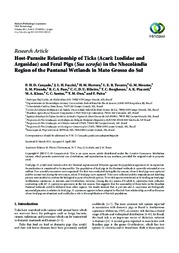Host-parasite relationship of ticks (Acari: Ixodidae and Argasidae) and feral pigs (Sus scrofa) in the Nhecolândia region of the Pantanal wetlands in Mato Grosso do Sul.
Host-parasite relationship of ticks (Acari: Ixodidae and Argasidae) and feral pigs (Sus scrofa) in the Nhecolândia region of the Pantanal wetlands in Mato Grosso do Sul.
Autoria: CANCADO, P. H. D.; FACCINI, J. L. H.; HERRERA, H. M.; TAVARES, L. E. R.; MOURAO, G.; PIRANDA, E. M.; PAES, R. C. S.; RIBEIRO, C. C. D. U.; BORGHESAN, T. C.; PIACENTI, A. K.; KINAS, M. A.; SANTOS, C. C.; ONO, T. M.; PAIVA, F.
Resumo: Feral pigs (S. scrofa) were introduced to the Pantanal region around 200 years ago and the population appears to be in expansion. Its eradication is considered to be impossible. The population of feral pigs in the Pantanal wetlands is currently estimated at one million. Two scientific excursions were organized. The first was conducted during the dry season, when 21 feral pigs were captured and the second was during the wet season, when 23 feral pigs were captured. Ticks were collected and the oviposition and hatching process were studied to confirm the biological success of each tick species. Three tick species were found to be feeding on feral pigs: Amblyomma cajennense, A. parvum, and Ornithodoros rostratus. During the dry season, 178 adult A. cajennense were collected, contrasting with 127 A. cajennense specimens in the wet season. This suggests that the seasonality of these ticks in the Brazilian Pantanal wetlands could be different from other regions. The results indicate that A. parvum and A. cajennense are biologically successful parasites in relation to feral pigs. A. cajennense appears to have adapted to this tick-host relationship, as well as the areas where feral pigs are abundant, and could play a role in the amplification of this tick population.
Ano de publicação: 2013
Tipo de publicação: Artigo de periódico
Unidade: Embrapa Gado de Corte
Palavras-chave: Feral pigs, ticks
Observações
1 - Por padrão são exibidas publicações dos últimos 20 anos. Para encontrar publicações mais antigas, configure o filtro ano de publicação, colocando o ano a partir do qual você deseja encontrar publicações. O filtro está na coluna da esquerda na busca acima.
2 - Para ler algumas publicações da Embrapa (apenas as que estão em formato ePub), é necessário ter, no celular ou computador, um desses softwares gratuitos. Sistemas Android: Google Play Livros; IOS: iBooks; Windows e Linux: software Calibre.
Acesse outras publicações
Acesse a Base de Dados da Pesquisa Agropecuária (BDPA) para consultar o acervo completo das bibliotecas da Embrapa.

